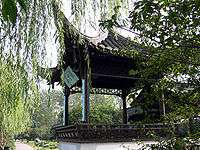Zheng Xie

Herbaceous peony viewing pavilion with Zheng Xie calligraphed horizontal board in Thin West Lake of Yangzhou
Zheng Xie (simplified Chinese: 郑燮; traditional Chinese: 鄭燮; pinyin: Zhèng Xiè) (1693–1765), commonly known as Zheng Banqiao (simplified Chinese: 郑板桥; traditional Chinese: 鄭板橋; pinyin: Zhèng Bǎnqiáo) was a Chinese painter from Jiangsu. He began life in poverty, but rose in the exam system to become a magistrate at Shandong. However, after 12 years, he became critical of the life of an official as he refused to ingratiate himself with senior officials. When he was reportedly criticized for building a shelter for the poor, he resigned. After that, he expressed himself in art and became one of the Eight Eccentrics of Yangzhou. He was noted for his drawing of orchids, bamboo, and stones. In 1748 he briefly resumed an official career as "official calligrapher and painter" for the Qianlong Emperor.
Zheng was also a calligrapher who created a new calligraphy style influenced by his orchid drawings. Added to this, he had an interest in literature and poetry. He preferred to write about ordinary people in a natural style.

Calligraphical work of Zheng Xie, now collected in Shandong Museum
External links
 |
Wikimedia Commons has media related to Zheng Xie. |
%2C_1762%2C_Qing_Dynasty%2C_Shanghai_Museum.jpg)
